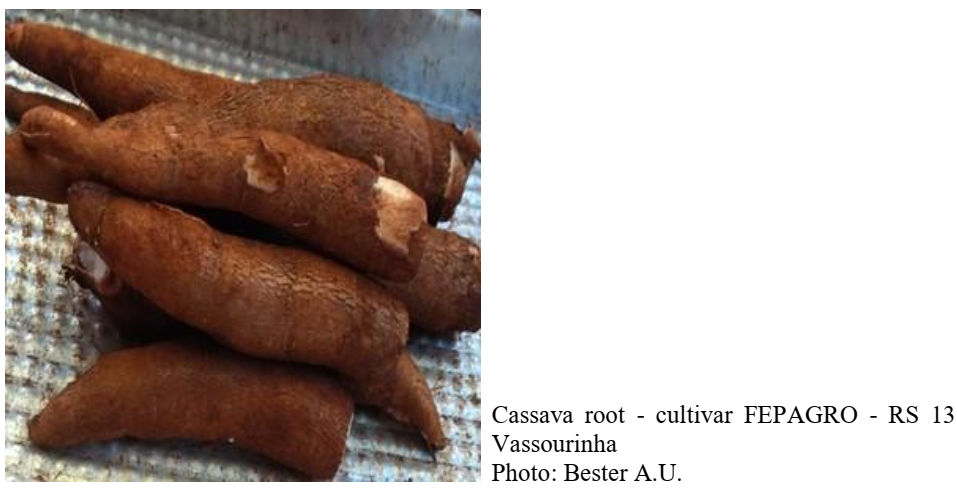Genetic contributions to productivity and nutritional aspects in cassava crops

Abstract
This study aimed to highlight the behavior of cassava cultivars when subjected to different densities and biostimulants at planting and to select superior cultivars based on nutritional and productive attributes using the multivariate approach. The experiment design used randomized blocks in a three-factor scheme, with three cassava cultivars (FEPAGRO-RS 13 Vassourinha, BRS CS01, Iapar - 19 Pioneira) × two planting densities (10 and 20 buds per linear meter) × two biostimulator forms (with and without) in three replications, totaling 36 experiment units. Cultivar BRS CS01 had the highest yield and concentration of mineral material, genotype FEPAGRO - RS 13 Vassourinha had the highest lipid content, and Iapar 19 - Pioneira had the highest protein concentrations. The starch content was tested with a comparison of means and MGIDI index. Cultivar FEPAGRO - RS 13 Vassourinha had the highest content and, according to the index, was the ideal cultivar based on multi-characteristics. Density 10 with the biostimulator was favorable for productivity and lipids, whereas density 10 without the biostimulator was favorable for starch, lipids, proteins and productivity. Density 20 with the biostimulator was favorable for lipids.
Keywords
Manihot esculenta Crantz, Heritability, MGIDI index, Density, Biostimulator
References
- Albuquerque, J.A.A., T. Sediyama, A.A. Silva, J.M.A. Alves, E.L. Finoto, F.A. Neto, and G.R. Silva. 2012. Desenvolvimento da cultura de mandioca sob interferência de plantas daninhas. Planta Daninha 30(1), 37-45. Doi: https://doi.org/10.1590/S0100-83582012000100005
- Annicchiarico, P. 1992. Cultivar adaptation and recommendation from alfafa trials in Northern Italy. J. Genet. Breed. 46(1), 269-278.
- AOAC, Asssociation of Official Analytical Chemists. 2005. Official methods of analysis. 18th ed. Gaithersburg, MD.
- Barbosa, M.H., I.R. Carvalho, J.A.G. Silva, D.A. Magano, V.Q. Souza, V.J. Szareski, F. Lautenchleger, D.J. Hutra, N. Moura, and M.V. Loro. 2021. Contribution of the additive genetic effects in soybean breeding aiming at the agronomic ideotype. Funct. Plant Breed. J. 3(1), 1. Doi: https://doi.org/10.35418/2526-4117/v3n1a1
- Baretta, D., M. Nardino, I.R. Carvalho, A.C. Oliveira, V.Q. Souza, and L.C. Maia. 2016. Performance of maize genotypes of Rio Grande do Sul using mixed models. Científica 44(3), 403-411. Doi: https://doi.org/10.15361/1984-5529.2016v44n3p403-411
- Bester, A.U., I.R. Carvalho, J.A.G. Silva, D.J. Hutra, N.B. Moura, F. Lautenchleger, and M.V. Loro. 2021. Three decades of cassava cultivation in Brazil: Potentialities and perspectives. Rev. Colomb. Cienc. Hortic. 15(2), e12087. Doi: https://doi.org/10.17584/rcch.2021v15i2.12087
- Borges, V., P.V. Ferreira, L. Soares, G.M. Santos, and A.M.M. Santos. 2010. Seleção de clones de batata-doce pelo procedimento REML/BLUP. Acta Sci. Agron. 32(4), 643-649. Doi: https://doi.org/10.4025/actasciagron.v32i4.4837
- Carvalho, L.P., F.J.C. Farias, C.L. Morello, and P.E. Teodoro. 2016. Uso da metodologia REML/BLUP para seleção de genótipos de algodoeiro com maior adaptabilidade e estabilidade produtiva. Bragantia 75(3), 314-321. Doi: https://doi.org/10.1590/1678-4499.275
- Carvalho, I.R., J.A.G. Silva, L.L. Ferreira, V.E. Bubans, M.H. Barbosa, R.B. Mambrin, S.M. Fachi, G.G. Conte, and V.Q. Souza. 2019. Heritability profiles defined by hierarchal models and artificial neural networks for dual-purpose wheat attributes. Genet. Mol. Res. 18(3), gmr18266. Doi: https://doi.org/10.4238/gmr18266
- CQFSRS, Comissão de Química e Fertilidade do Solo. 2004. Manual de adubação e calagem para os Estados do Rio Grande do Sul e de Santa Catarina. 10th ed. Sociedade Brasileira de Ciência do Solo, Porto Alegre, Brazil.
- Costa, R.B., M.D.V. Resende, A.J. Araújo, P.S. Gonçalves, and N. Bortoletto. 2000. Seleção combinada univariada e multivariada aplicada ao melhoramento genético da seringueira. Pesq. Agropec. Bras. 35(2), 381-388. Doi: https://doi.org/10.1590/S0100-204X2000000200017
- Cruz, C.D., P.C.S. Carneiro, and A.J. Regazzi. 2014. Modelos biométricos aplicados ao melhoramento genético. 3th ed. Editora UFV, Viçosa, Brazil.
- Facchinello, P.H.K., I.R. Carvalho, E.A. Streck, G.A. Aguiar, J. Goveia, M. Feijó, R.R. Pereira, P.R.R. Fagundes, L.C. Maia, F. Lautenchleger, and A.M. Magalhães Junior. 2021. Gene action and genetic parameters of characters related to rice grain quality. Agron. J. 113, 4736-4752. Doi: https://doi.org/10.1002/agj2.20881
- FAO. 2019. Protecting cassava, a neglected crop, from pests and diseases. Rome.
- Ferrari, M., I.R. Carvalho, A.J. Pelegrin, V.J. Szareski, M. Nardino, T.C Rosa, N.L. Santos, T.S. Martins, V.Q. Souza, A.C. Oliveira, and L.C. Maia. 2022. Heritability and genetic distance from s1 maize progenies. Commun. Plant Sci. 12, 7-15. Doi: https://doi.org/10.26814/cps2022002
- NASSAR, N. M. A. 2006. Mandioca. Ciência Hoje. vol. 39, nº 231.
- Oliveira, E.J., F.F. Aud, C.F.G. Morales, S.A.S. Oliveira, and V.S. Santos. 2016. Non-hierarchical clustering of Manihot esculenta Crantz germplasm based on quantitative traits. Rev. Cienc. Agron. 47(3), 548-555. Doi: https://doi.org/10.5935/1806-6690.20160066
- Oyeyinka, S.A., A.A. Adeloye, O.O. Olaomo, and E. Kayitesi. 2020. Effect of fermentation time on physicochemical properties of starch extracted from cassava root. Food Biosci. 33, 100485. Doi: https://doi.org/10.1016/j.fbio.2019.100485
- Pádua, G.J. 2018. Recursos genéticos aplicados ao melhoramento genético de plantas. In: Amabile, R.F., M.S. Vilela, and J.R. Peixoto (eds.). Melhoramento de plantas: variabilidade genética, ferramentas e mercado. Sociedade Brasileira de Melhoramento de Plantas, Brasília, D.F.
- Pimentel, A. J. B. Guimarães, J. F. R. Souza, M. A. Resende, M. D. V. Moura, L. M. Rocha, J. R. A. S. C. Ribeiro, G. 2014. Estimação de parâmetros genéticos e predição de valor genético aditivo de trigo utilizando modelos mistos. Pesq. Agropec. Bras. 49(11), 882-890. DOI: 10.1590/S0100-204X2014001100007
- Ramalho, M., J.B. Santos, C.B. Pinto, E.A. Souza, F.M.A. Gonçalves, and J.C. Souza. 2012. Genética na agropecuária. 5th ed. UFLA, Lavras, Brazil.
- Rosa, T.C, I.R. Carvalho, J.A.G. Silva, V.J. Szareski, T.A. Segatto, E.D. Port, M.V. Loro, H.C.F. Almeida, A.C. Oliveira, L.C. Maia, and V.Q. Souza. 2021. Genetic parameters and multi-trait selection of white oats for forage. Genet. Mol. Res. 20(2), gmr18451. Doi: https://doi.org/10.4238/gmr18451
- Santos, H.G. P.K.T. Jacomine, L.H.C. Anjos, V.A. Oliveira, J.F. Lumbreras, M.R. Coelho, J.A. Almeida, J.C. Araujo Filho, J.B. Oliveira, and T.J.F. Cunha. 2018. Sistema brasileiro de classificação de solos. 5th ed. Embrapa, Brasília, DF.
- Soxhlet, F. 1879. Die gewichtsanalytische Bestimmung des Milchfettes. Dinglers Polytech. J. 232, 461-465.
- Teixeira, P.R.G., A.E.S. Viana, A.D. Cardoso, G.L.P. Moreira, S.M. Matsumoto, and P.A.S. Ramos. 2017. Características físico-químicas de variedades de mandioca de mesa. Rev. Bras. Ciênc. Agrár. 12(2), 158-165. Doi: https://doi.org/10.5039/agraria.v12i2a5433
